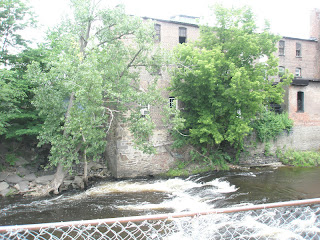Monument Square
Six years ago Fred
Bernstein wrote in the New York Times travel section that “Troy has one of the most perfectly preserved 19th
century downtowns in the United States” and a recent visit proves he is still
right:
Drive
into the city, and you'll find block after block of town houses, churches and
commercial buildings that look almost exactly as they did 100 years ago. A
1,200-seat concert hall has stunning frescoes and astonishing acoustics. A row
of antiques stores inhabits buildings at least as precious as the merchandise
inside. And a remarkable Tiffany window forms the backdrop for the circulation
desk at the beaux-arts public library.
According to Bernstein,
after World War II the local economy declined so suddenly that much of
the original architecture has been preserved intact. And in contrast to many of
the other old upstate industrial cities we have visited, the housing stock in
Troy is occupied and in good repair. The presence of two colleges, Rensselaer
Polytechnic Institute and Russell Sage College have certainly contributed to
this outcome. And a good number of hard-working lower income people have come
north from New York City in recent decades, taking advantage of low cost
housing no longer available in the metropolis.
An old mill on the Poestenkill Creek
Troy’s architecture
reveals many layers of industrial development, with some factory buildings
doubtless used by many succeeding industries over a period of two centuries. One
of the very earliest industries was the production of nails, horseshoes and
other iron implements, drawing on the extensive iron mines in the nearby upstate
mountains.
The Burden Iron Works Museum
An interesting look at this era can
be found at The Burden Iron Works Museum next to the railroad tracks at 1 East
Industrial Parkway:
The museum building itself served as the offices for the Burden Iron Works Company. It grew out of the Troy Iron and Nail Factory, but Scotsman
Henry Burden took it from a little local operation to one of the most important
iron mills of its day. Burden patented a machine that could make horseshoes and the
company scored a contract to make the horseshoes for the Union Army. At its
peak the iron works was grossing $400 million (in today's money) just in horseshoes.
Two gents with detachable collars
The next great industry in Troy
sprang from what now seems a peculiar fashion necessity of 19th
century males: detachable collars and cuffs. In 1825 a local woman, Hannah
Montague is said to have grown tired of washing her husband’s shirts when only
the cuffs and collars were dirty. She made her life easier by developing a detachable
collar that could be cleaned and starched separately from the shirt. Soon
enough, a host of factories had sprung up in Troy to manufacture such collars
and cuffs –and with them a great many laundries to wash and iron the detachable
fashion accessories.
The Troy Record building
These labor-intensive industries
were the setting for the nation’s first female labor union in 1864, led by a
formidable young Irish immigrant. The 19 year old Kate Mullaney and girls like
her worked 14 hour days in laundries specializing in the detachable accessories,
earning no more than three or four dollars a week. Influenced by the male Iron
Moulders Union, Kate and her friend Esther Keegan organized the Collar Laundry
Union with 300 or the approximately 3000 Troy women employed in the collar and
laundry trades.
Supported by, and supporting their male colleagues among the Iron Moulders, Kate’s union went on strike for higher wages in 1866, and won. In 1868 she led another walkout and won an additional increase in wages, and that same year she was elected vice president of the National Labor Congress at a New York City Conference. In 1869 the union established its own cooperative laundry, a new advance in the labor movement. The manufacturers countered by floating rumors in the press of a new, disposable paper collar which led to a collapse of the cooperative, and a year later to the dissolution of the union. Kate, whose labor career ended before she was 30, married and lived an apparently quiet life until her death in 1906.
Kate Mullany House dedication
Although in the end her union did not survive, Kate Mullany’s achievements have not been forgotten and in
1998 Senator Hillary Clinton joined local activists to dedicate Kate’s home at 850
3rd Street as a National Historic Site.
River Street
If you are thinking of a short visit
to downtown Troy, you could do no better than follow the walking tour suggested
by Fred Bernstein. Start with a snack or coffee at Illlium, a café on Broadway
on the edge of Monument Square. Then follow River Street to the antique shops. Many small businesses are located in the classic Victorian buildings on these streets.
Market Block Books on River Street
No Name Design on Fifth Avenue
Cary Organ Co. on Jefferson Street
Troy Pork Store at 4th and Ferry Streets
Be sure to continue at least as far Washington
Park, between Second and Third Streets and Washington Place and Washington Street, a gated park resembling Gramercy Park in
Manhattan.
Troy Public Library
From there walk north on
Second Street to the Troy Public Library, where Tiffany windows and Hudson
River paintings adorn the classic structure.
The Rensselaer County Court House
Also on Second Street is the historical society and the Troy Savings Bank MusicHall, known for its regular schedule of concerts.
Russell Sage campus
But you really don’t need to follow
any set route - just wander where you
will in this movie setting of a town and imagine yourself in the world of a
hundred and more years ago. (You won’t be surprised to learn that Troy was the
setting for Martin Scorsese’s Age of Innocence in 1993.)
Martin Scorsese directing Michelle Pfeiffer and Daniel Day Lewis





















